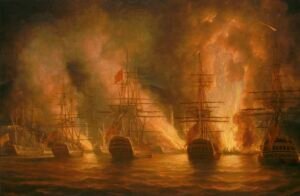The Capture of Trinidad – 18 February 1797
In the early months of 1797, Great Britain began its campaign against the Spanish overseas possessions with an invasion of Trinidad. Excellent reconnaissance by Captain James Athol Wood resulted in an almost flawless assault, which also saw a potentially dangerous Spanish squadron neutralised.
After Spain had declared war against Britain in the autumn of 1796, plans were made to seize her overseas possessions, and in particular Trinidad and Puerto Rico. Accordingly, Lieutenant-General Sir Ralph Abercromby was ordered to return to the West Indies from London to co-operate with the commander-in-chief of the Leeward Islands, Rear-Admiral Henry Harvey, in an assault upon those two islands. In mid-November he had departed Portsmouth aboard the frigate Arethusa 38, Captain Thomas Wolley.
Arriving at Fort Royal, Martinique in early January 1797, Abercromby spent a month gathering his troops together and planning his campaign. Trinidad was chosen to be the initial target, partly at the urging of Captain James Athol Wood (commanding the sloop Favourite 16 ), an experienced 40-year-old officer who was already familiar with the island. Wood was ordered to reconnoitre the Spanish defences, arriving off Trinidad on 8 January. He despatched a fast sailboat, which had been painted black to give the appearance of a canoe, to land an officer on a small, thickly wooded island. There he spent the next 24 hours making observations, unseen by the Spanish. That night Wood had a boat from the Favourite row around the three sail of the line anchored in Chaguaramas Bay to determine their crews’ alertness. His subsequent report to Harvey, dated 13 January, clearly advised that an attack was feasible; based on this information, Harvey instructed Wood to develop a plan for the amphibious assault.
On 12 February several troop transports set sail from Martinique in company with Harvey’s warships. Two days later off the small island of Carriacou they rendezvoused with the Invincible 74, escorting two transports with part of the 14th Regiment from Barbados. They were also joined by Wood’s Favourite, which had embarked troops at St. Vincent, and the sloops Thorn 16 and Zebra 16, which had collected a detachment from Tobago. These additions brought the naval force up to five sail of the line, two frigates, and six other vessels.
On the afternoon of 16 February, the squadron sailed through the Great Boca Channel on the west side of Trinidad into the Gulf of Paria. As Wood had reported, they found an enemy squadron of four sail of the line and a frigate anchored in Chaguaramas Bay under the protection of a battery of twenty guns and three mortars on the nearby Gaspar Grande Island. This force, which had its sails bent and appeared ready for sailing, was under the command of Rear-Admiral Don Sebastien Ruiz de Apodaca, and consisted of: the flagship San Vincente 80, Captain Don Geromino Mendoza; Gallardo 74, Captain Don Gabriel Sorendo; Arrogante 74, Captain Don Raphael Benesa; San Damazo 74, Captain Don Torres Jardon; and the frigate Santa Cecilia 34, Captain Don Manuel Urtesabel.
Harvey anchored his troopships in the Gulf of Paria five miles from the main town of Port of Spain under the protection of the Arethusa, Thorn and Zebra. Leaving the frigate Alarm 32, the Favorite and the sloop Victorieuse 14 to patrol, shortly before dusk the admiral took his ships of the line into Chaguaramas Bay, anchoring in line of battle at long cannon-shot from the enemy. This position allowed the Spanish ships no possibility of escape, and as they were seriously undermanned it would have been suicidal for them to attack the British squadron. At 2 a.m. on the 17th the British discovered that the enemy had set their vessels alight – at daylight it became apparent that only the San Damaso 74 could be saved, causing Harvey to send his boats in to cut her out. At about this time, Gaspar Grande Island was also abandoned by its defenders.
With the threat of the Spanish men-of-war and battery neutralised, Abercromby ordered his troops to land some three miles west of Port of Spain, with the landing directed by Captain Wolley of the Arethusa, and covered by the guns of the Favourite. As soon as the first 400 men were ashore they began their advance, encountering little resistance. By evening the town and its environs were in British hands; Governor Don José Maria Chacón authorised the capitulation the following morning, and the Spanish troops lay down their arms that evening. The sole British casualty was a brigade major who had been fatally wounded.
In recognition of his efforts, Captain Wood received the Spanish colours and was appointed to the San Damaso by Harvey, while the rear-admiral’s nephew and flag-captain, John Harvey, was given the honour of taking home of the despatches. They would be delivered to the Admiralty on the morning of 27 March. Meanwhile, back in the Leeward Islands where Trinidad would be retained by Britin following the Treaty of Amiens in 1802, Harvey and Abercromby began preparing for an attack on Puerto Rico, which eventually failed against stubborn Spanish resistance
Ships Participating:
| Prince of Wales 98 | Rear-Admiral Henry Harvey |
| Flag Captain John Harvey | |
| Bellona 74 | Captain George Wilson |
| Vengeance 74 | Captain Thomas Macnamara Russell |
| Invincible 74 | Captain George William Cayley |
| Scipio 64 | Captain Charles Davers |
| Arethusa 38 | Captain Thomas Wolley |
| Alarm 32 | Captain Edward Fellowes |
| Favorite 16 | Commander James Athol Wood |
| Pelican 16 | Commander Thomas Harvey |
| Thorn 16 | Commander John Hamstead |
| Zephyr 14 | Commander Robert Laurie |
| Victorieuse 14 | Commander Edward Stirling Dickson |
| Terror bomb | Commander Joseph Westbeach |

